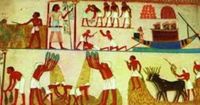In the heart of Luxor, a city steeped in ancient history, the celebration of the Spring Festival, known as "Sham El-Nessim," is a vibrant reminder of Egypt's rich cultural heritage. This festival, which has been observed for approximately 4,700 years, is rooted in the agricultural traditions of the ancient Egyptians, who revered the arrival of spring as a time of renewal and celebration.
Sham El-Nessim, which translates to "smelling the breeze," signifies the rebirth of nature and the beginning of a new agricultural year. The name derives from the ancient Egyptian word "Shamo," meaning "harvest," highlighting the festival's deep agricultural significance. According to Dr. Mustafa Waziri, former Secretary-General of the Supreme Council of Antiquities, the festival is not just a remnant of the past but a living tradition that continues to resonate with modern Egyptians.
As the festivities unfold, the city of Esna, historically known as "Latopolis" or "the city of fish," plays a pivotal role. This ancient city has long been a center for the fish salting industry, particularly famous for its salted fish dishes like "feseekh" and "herring," which are staples of the Sham El-Nessim feast. Dr. Waziri notes that the Egyptians' enthusiasm for consuming fish on this day harkens back to Pharaonic times, when such culinary practices were integral to their cultural identity.
The origins of Sham El-Nessim can be traced back to the agricultural calendar of ancient Egypt, which divided the year into three seasons: the inundation (Akhet), the emergence (Pert), and the harvest (Shamo). The festival occurs during the harvest season, symbolizing the culmination of agricultural efforts and the renewal of life. It is believed that the official celebration began around 2700 BC, during the transition from the Third to the Fourth Dynasty, although its roots likely extend back even further.
During Sham El-Nessim, Egyptians engage in various outdoor activities, enjoying picnics in lush green spaces along the Nile. This practice reflects the ancient Egyptians' profound connection to nature, as they sought to celebrate the beauty and bounty of the earth. The festival is characterized by communal gatherings, where families and friends come together to share traditional foods, music, and joy.
Dr. Gharib Sunbat, an antiquities expert and former director of Karnak Antiquities, emphasizes that the ancient Egyptians meticulously documented their celebrations of Sham El-Nessim on temple walls and tombs. This dedication to recording their cultural practices underscores the significance they placed on the festival as a celebration of life and nature. The ancient Egyptians believed that life originated from water, and thus, the Nile River was revered as a source of sustenance and vitality.
The culinary traditions associated with Sham El-Nessim are rich and varied. Common foods include salted fish, onions, and eggs, each carrying symbolic meanings. For instance, eggs symbolize new beginnings and rebirth, reflecting the ancient belief in creation. Dr. Waziri explains that the Egyptians would often inscribe their wishes on eggs and place them in baskets made from palm fronds, hoping to receive blessings from the gods during the festival.
Salted fish, particularly "feseekh," has a storied history in Egyptian culture. It was not only a dietary staple but also believed to possess medicinal properties, used to treat ailments related to the heat of spring. The preparation of salted fish was an art form, with specialized workshops dedicated to its production, as evidenced by inscriptions found in ancient tombs.
Moreover, the consumption of green onions was linked to a myth about a young prince who was cured of a serious illness through the use of this vegetable, further embedding it within the cultural fabric of Sham El-Nessim. The ancient Egyptians viewed the act of eating these traditional foods as a means of connecting with their ancestors and honoring their agricultural heritage.
As the festival has evolved, it has retained its essence, blending ancient customs with modern practices. Today, Sham El-Nessim is celebrated by Egyptians of all backgrounds, transcending religious and cultural divides. It serves as a unifying force, bringing people together to celebrate the arrival of spring and the beauty of life.
The importance of Sham El-Nessim in contemporary Egyptian society cannot be overstated. It is a day of joy, laughter, and community, where the spirit of the ancient Egyptians lives on. Families flock to parks, gardens, and riversides, embracing the warmth of the sun and the gentle breeze that heralds the season of growth.
In the words of the ancient Egyptians, as recounted by Dr. Waziri, "Spend a happy day, and put incense and fine oil on your face, while your beloved wife is in your heart beside you. Let go of worries behind you. Do not remember anything but joy." This sentiment encapsulates the essence of Sham El-Nessim—a celebration of life, renewal, and the enduring connection between the past and present.
As Egyptians gather to celebrate Sham El-Nessim this spring, they not only honor their ancestors but also reaffirm their commitment to preserving their rich cultural heritage. The festival stands as a testament to the resilience of traditions that have withstood the test of time, continuing to inspire generations to come.





